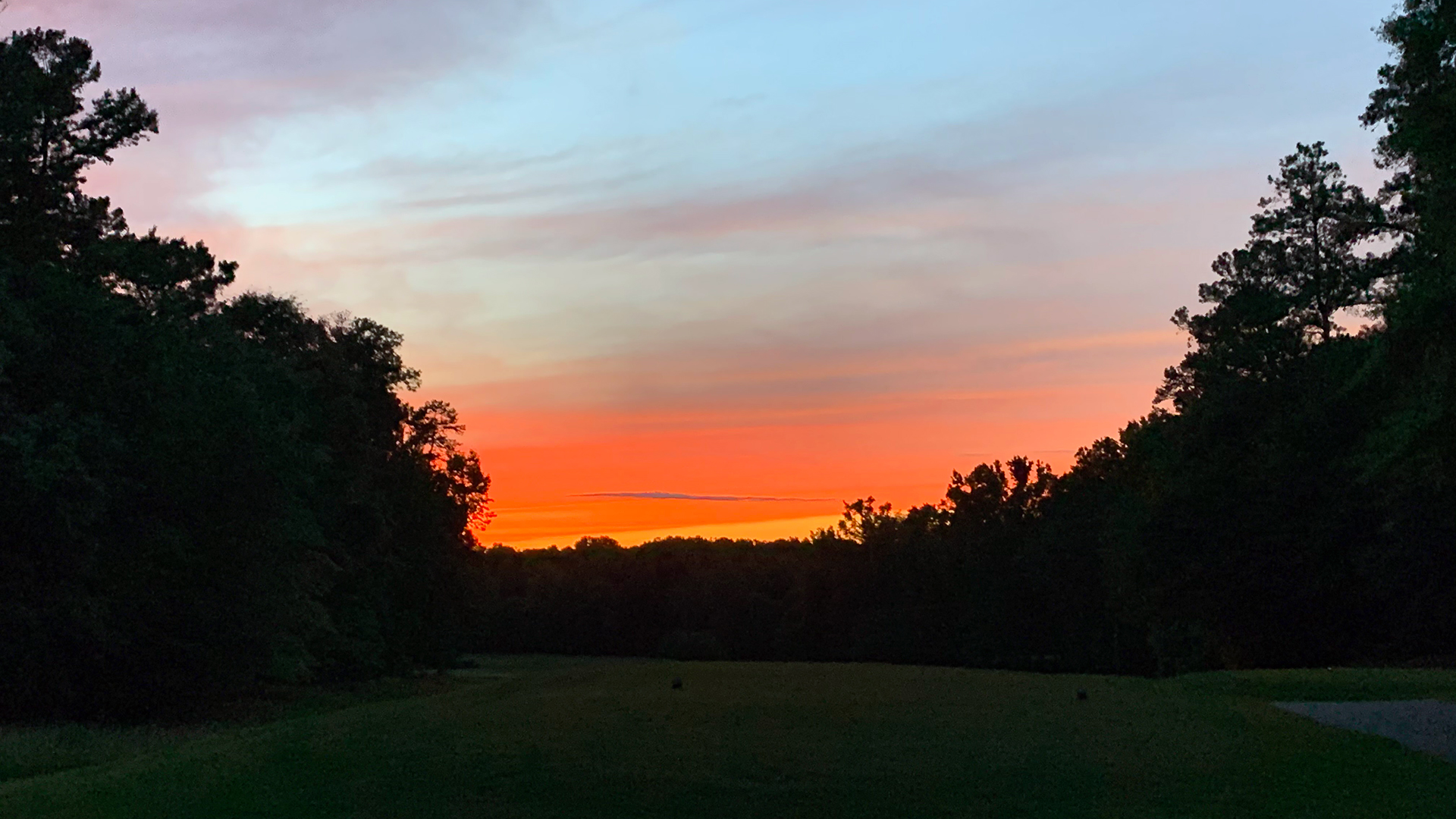
The Ever-Changing Colors of the South
Young Ellen Corry moves to Manhattan and discovers the South will not leave her.
Where I’m from, there is a pasture adjacent to an old Baptist church.
It’s confined by an unornamented metal fence; a small forest bounds the other side. Sweeping wind animates the trees, drawing haunting silhouettes as the sun slips away. Tractor tread embosses the other side of the fence, exposing Georgia’s raw red clay. In the right light, the cows look like they are ordained by beams from God. They return to overgrazed land with faith that it will revert to abundance if they roam far enough. Inside the fence, calves stick close to their mothers. The cows seem preoccupied with filling their own bellies, but they’re showing the young ones the way. Some people have the idea that cows are simple creatures, alive only to make milk and graze cud. But they form intense friendships and extreme maternal bonds with their young, existing happily in a world that provides for them.
In a weird way, that cow pasture represents a microcosm of the small town that I’m from. It’s a bubble of bliss allowing people to thrive in an ecosystem designed for them; a world of explicit rules.
The element that makes my perception of this quaint pasture shift is the sky. After living in New York City for a year, I appreciate nothing more than the wide-open sky of small-town Georgia. If a painter sat before my small pasture and attempted to capture it accurately, they never could. The colors are ever changing, reds and pinks and blues and oranges and purples. As the colors shift, I shift with them. Oranges and pinks beget a sense of warmth. Blues and purples engender nostalgia for a place I will never stay for a prolonged time. My hometown, the one holding the simple pleasures of farm life and football games, will never be my permanent residence again. But the cows welcome me home as if I never left.
I resented this plain way of living when it was my constant routine. I could not stand the insular nature—I clawed at the barriers, hoping to run far away. So, I did. But when I again immersed myself in this uncomplicated way of living, my eyes flooded with tears. A four-day trip home for Thanksgiving brought more than my grandma’s green bean casserole: it brought a reassessment of my life. Fifteen-minute drives, with me singing loudly, lingered with me much more than they did the summer before I left for school. The simple presence of cattle humbled me into longing for this place I once despised.
I moved to New York in August of 2022 to start my freshman year at New York University. Living in New York for almost a year now, I’ve only returned to Watkinsville on holiday breaks. I was convinced greater things would only come if I got out. If I did not take the chance to leave, I would be stuck there forever.
I want what I cannot have. In New York, a fundamental element of me feels misplaced. Gone are the grocery store conversations with my elementary school teacher and the ungodly thing the humidity does to my hair.
I want what I cannot have. In New York, a fundamental element of me feels misplaced. Gone are the grocery store conversations with my elementary school teacher and the ungodly thing the humidity does to my hair. I have the inescapable feeling I left something at home, but cannot quantify what it is. To be a rural Southerner in New York is to be a fish out of water. My stories of sunsets spent watching the horses pass are met with mockery here—it’s a beauty too foreign and far away, I’m afraid.
“Oh God. How was that?” is a phrase I have heard countless times since moving to New York. Initially, I didn’t quite know how to respond. Now the wave of assumptions and prejudices make me chuckle. I could easily confirm every belief New Yorkers have about the podunk, simple-minded, American South. Yes, I have known my fair share of out-of-season camo apparel and blatantly racist ignoramuses. But I’ve also felt magnolia trees mothering me during my drives past places where old couples sell me peaches for a discounted price because they thought my dad was sweet in high school. At first, I went along with the harbored contempt for my home. I let my Southern identity take the backseat for a couple months. But I missed it.
People up here are so captivated by our tortured history they skim past the beauty that compels us to stay. Looking at headlines from my state recently, it would be hard for them to draw any other conclusions. In her second memoir, Maya Angelou wrote, “Despite the sarcastic remarks of Northerners, who don’t know the region, the South of the United States can be so impellingly beautiful that sophisticated creature comforts diminish in importance.” Every summer growing up, my grandparents would load me into the car for Wahsega 4-H camp in Dahlonega, Georgia. One night I spent so long throwing rocks in the creek to hear the slap echo through the trees that I missed the dinner bell. I’m sure my grandma whooped my behind for it, but I can only remember the summer nights where shoes were nowhere to be found.
The New Yorkers’ judgments break over me like all-consuming waves. Seeing my troubled Georgia through their eyes allows me to see my home in its entirety. In 2022, we almost elected a U.S. senator with domestic abuse allegations. Our governor’s 2018 campaign ads turned into a Saturday Night Live sketch. One of our U.S. representatives openly endorses conspiracy theories.
I needed hope; a reason not to close the door to where I came from. Wavering at an impasse of places to call home, I desired someone to tell me the South was deserving of pride. Tennessee’s Margaret Renkl made me feel that I was allowed to miss the South as I know it, and not constantly feel apologetic for what it represents. She wrote in The New York Times, not “every person in the entire state can be painted with the same brush.” We can champion those “who work to preserve what’s good about this beleaguered region and to heal what’s hateful.” Renkl and I must walk the tightrope of shame and pride: shame for every law passed that nullifies a woman’s right to choose or a human’s access to vote and pride for those who dedicate their lives to picking up the pieces.
But for every backward step the South takes, I see thousands of people who rise to the challenge of redeeming a region they love—the thousands glossed over every time the South is reduced to a redneck, gun-loving backcountry.
But for every backward step the South takes, I see thousands of people who rise to the challenge of redeeming a region they love—the thousands glossed over every time the South is reduced to a redneck, gun-loving backcountry. My neighbors, teachers, friends, and family work too hard to be reduced to ignorant villains.
If our detractors came down for a spot of Southern hospitality and a glass of sweet tea, they would realize we don’t all fit into their cartoonish stereotype. Jacqueline Allen Trimble is a poet and essayist living in Montgomery, Alabama, who debuted her first collection, American Happiness, in 2016. In her poem, “Everybody in America Hate the South,” she offers a beautifully complex examination of the region—a place we treat like “our crazy Aunt Hazel who runs naked through a house full of company shouting all the foolish things we think but can’t say.” The embarrassments of the South are manifestations of the unacknowledged beliefs of the suburban North. But “problematic” behaviors do not make a hard stop at the Mason-Dixon Line. Outside of New York City, most of the state’s counties are as red as northwest Georgia. Yet, as Trimble says, the South takes “on the sins of the whole country.”
Trimble opens her poem by saying the South is a “land filled to the rafters with ghosts of lynched boys and attics full of souvenirs.” Can we appreciate the South when it stands on the shoulders of slavery and oppression? It’s a question I fear I may never be able to answer, but I am trying.
When starved of the comforts of the South, I ache to catch a flight back home. I claim my Southern roots more and more as I long for rural life. I cling to my father’s twang and order sweet tea at any chance. I was slow to come to terms with the ground I stood on.
But reckoning was occurring while I focused on my escape. Our state is no longer a political lock, but a major swing state. Black-owned businesses opened in the same places that housed sharecroppers and demolished railroad tracks. Atlanta is now home to one of the leading film industries thanks to the efforts of Tyler Perry and countless others. Despite the divide, people have anchored down and decided to fix the South they love.
In my small pasture, I gazed at a small world. I could put my feet on every blade of grass and catalog the colors of the sky. What I failed to reckon with was that my own painting of Georgia was as dynamic as that ever-changing sky, red and blue in my circumscribed perfection. As my mood shifted with the colors on a sunset drive, my understanding was unknowingly shifting at a macrocosmic level. Georgia is coming to terms with its past—building on top of it, yet enshrined in the culture of where it has been. In only a year, the home I returned to felt vastly different from the home where I went to high school. I can’t claim to know how Georgia should reckon with its racist past. I am a teenage white girl from the middle of nowhere; I don’t believe I am remotely qualified to try. But I know that the place I return to on my short breaks is nothing like the South painted in political diatribes or one-minute TV news stories. It is changing, and we will continue to actively fight for it to actualize into a region that is indisputably defensible.
Ellen Corry is a rising sophomore at New York University, double majoring in drama and political science. She is originally from Watkinsville, Georgia, and loves returning there on school breaks. She is impelled to write by nature, a sense of home, and a struggle with her own coming of age.


This young writer is walking down a path so many of us have traveled.
Nice read.